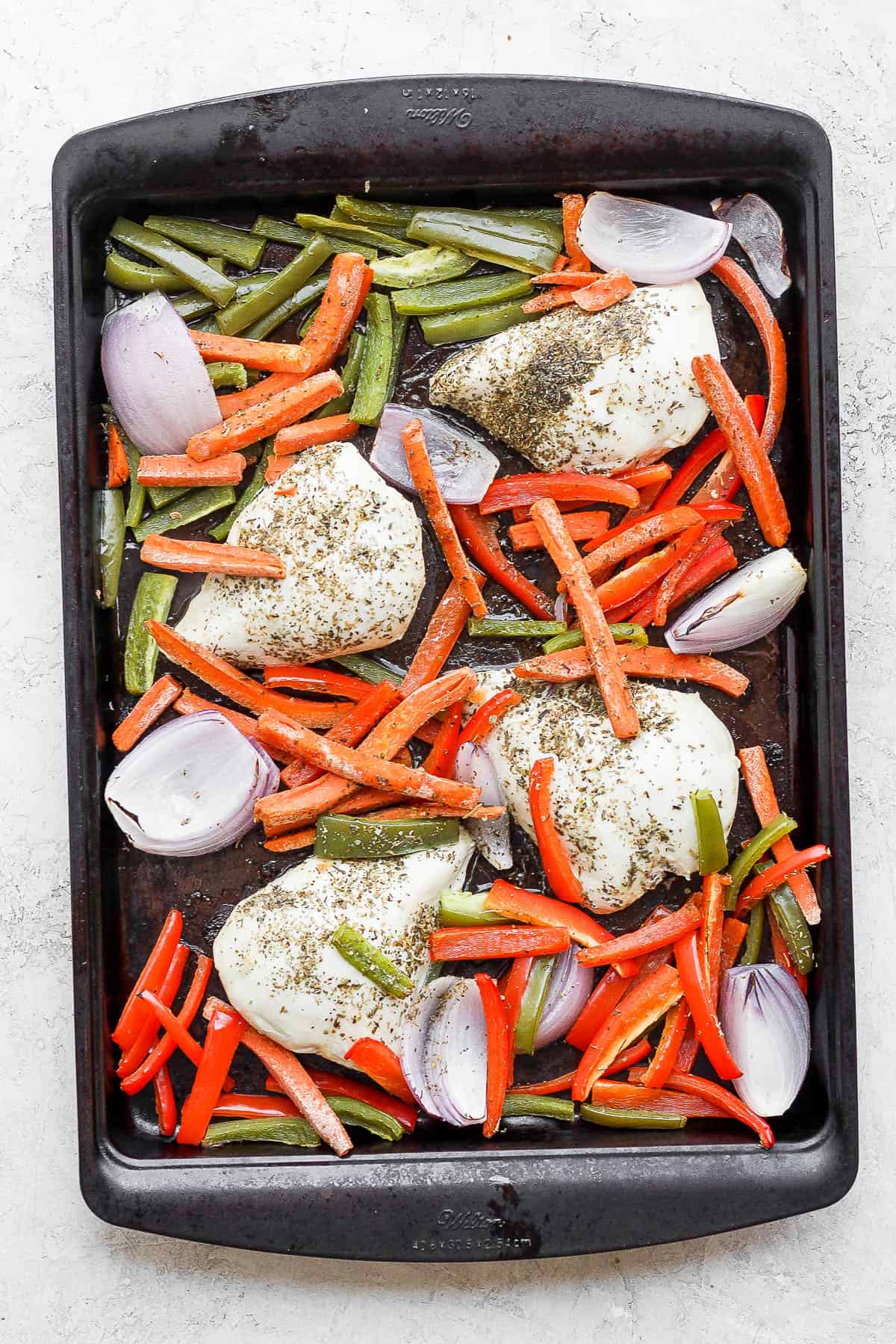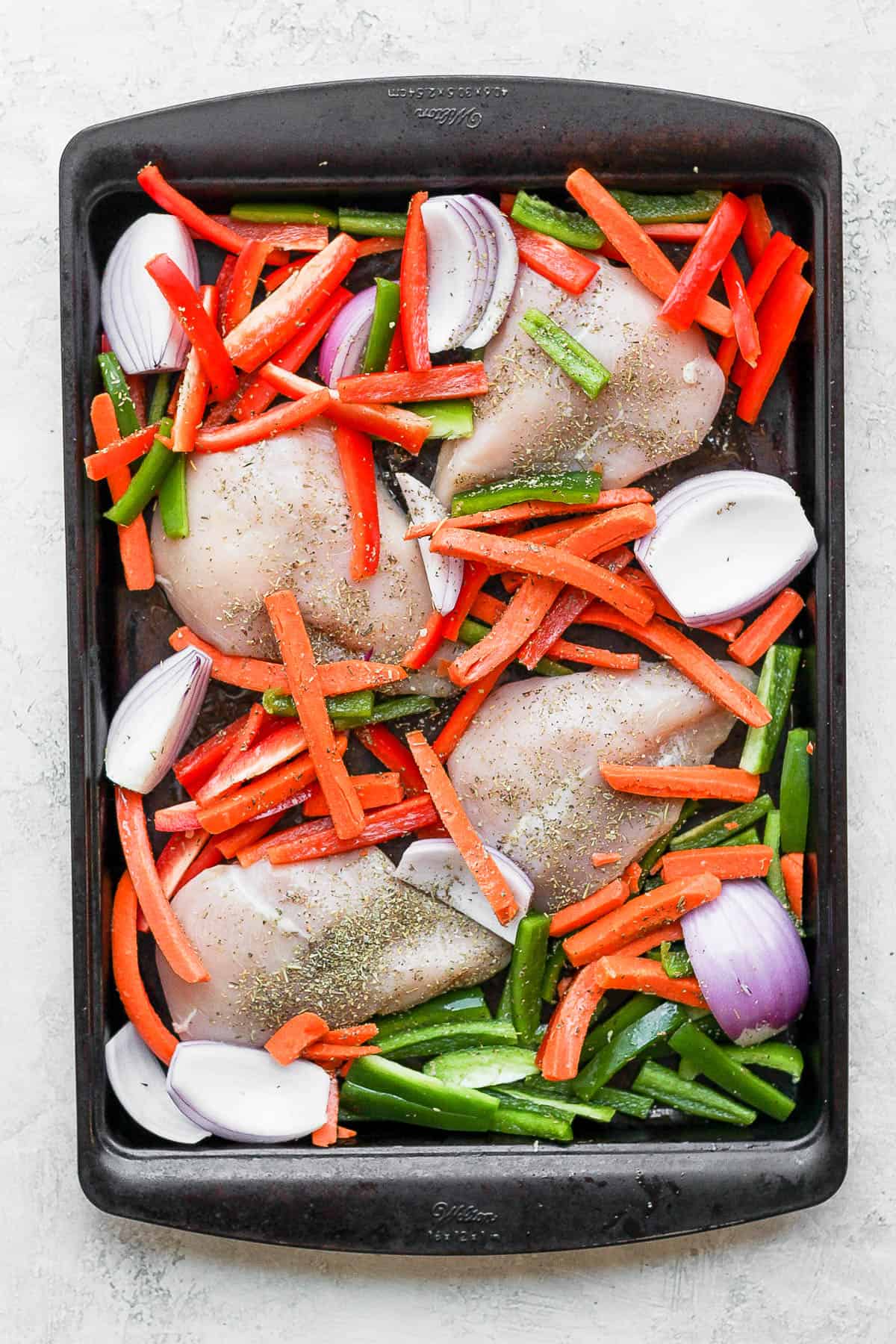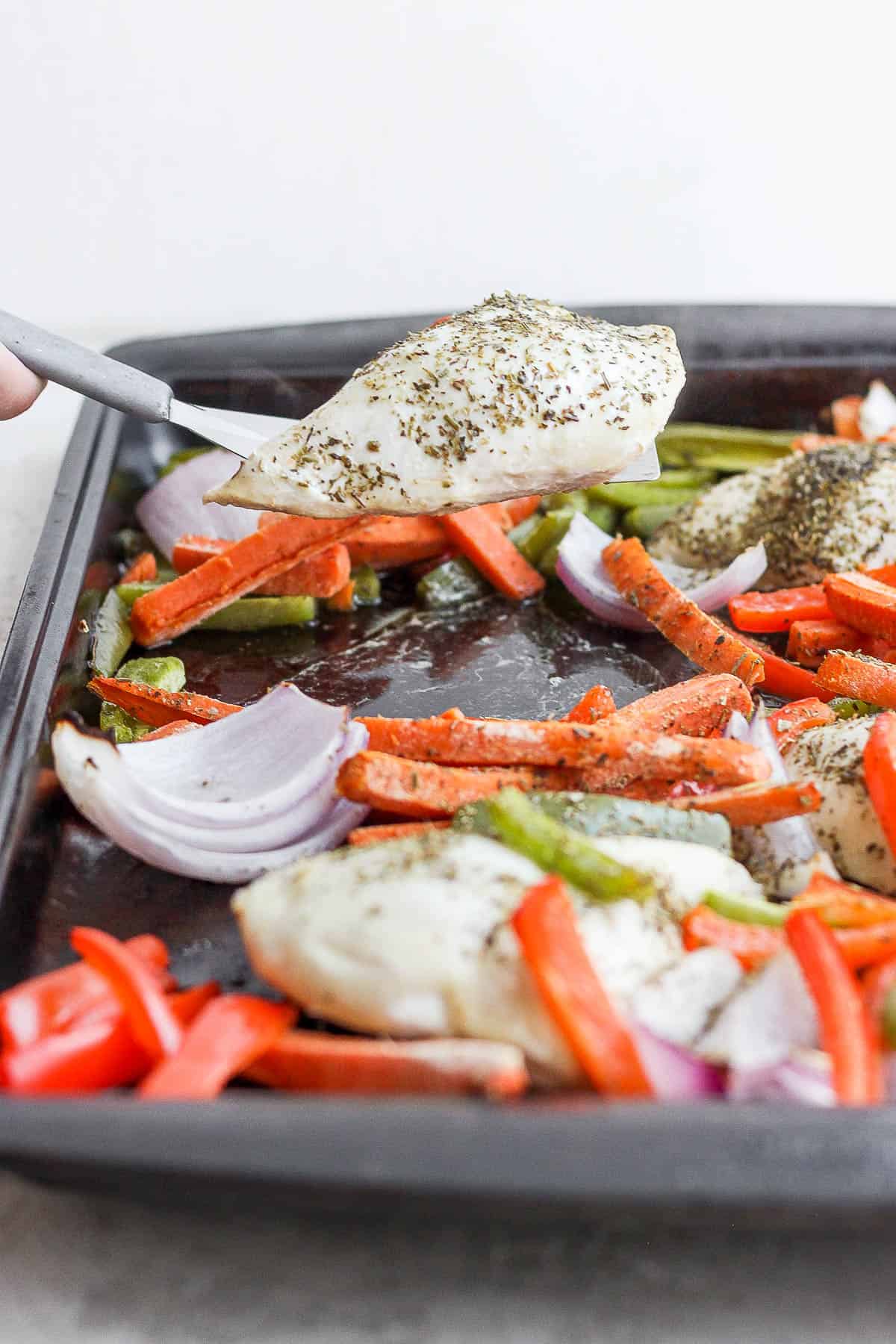How to Make Sheet Pan Meals
Published Jan 04, 2022
Here is a guide to sheet pan meals covering everything from what exactly is a sheet pan to how to make a sheet pan dinner without a recipe.
This post may contain affiliate links. Please read our disclosure policy.
If you’ve ever wondered what is a sheet pan meal or how to make sheet pan meals, this guide will help you and give you great ideas to try. You’ll see that there’s no need for a recipe as long as you keep in mind this simple guide.

What is a sheet pan meal?
A sheet pan meal is a full meal – protein and vegetable or vegetables– cooked together on a sheet pan in a hot oven, typically 425° F. The food combos are endless, but the recipes share a few attributes. They are fairly low fat, come together within an hour, and dirty just one pan.
What should i look for in a Sheet paN?
To achieve success with a dinner’s worth of ingredients at high heat you need a large pan with a rolled edge.
- Technically, sheet pans that fit into home ovens are called half-sheet pans. A true sheet pan (26″ x 18″) is made for the larger professional oven. Baking websites and restaurant supply stores will label what you want as “half sheet pans.”.
- “Seek out heavy aluminum pans, without nonstick coatings. Non-stick coatings will inhibit browning and not last very long when used in high heat
- Make sure your pan has a rolled edge of about 1″ to keep ingredients and juices from spilling all over the oven. (This is one reason rimless cookie sheets do not work.)
- Jelly roll pans (created specifically for rolled cakes) are slightly smaller (about 15″ x 10″) and also work, but not fit as many ingredients.

Sheet pan meal formula
The basic formula is:
- 2 pounds of protein
- 2 -3 cups of chopped vegetables.
- 1-2 tablespoons oil (usually olive oil)

Start with protein
Use up to 2 pounds of protein per half sheet pan. At 425°, most proteins cook in 30 minutes or less. All times are approximate. Bone-in meats take the longest. Fish goes fastest. Shrimp takes less than 10 minutes. Know the doneness temps for your protein, and check it often.
- Shrimp – Depending on size, 3-10 minutes
- Salmon and white fish – Depending on thickness 12-25 minutes
- Tofu – 20 minutes
- Lamb chops, 10- 20 minutes, depending on thickness
- Chicken, bone-in or boneless, 20 -30 minutes
- All types of whole sausages, about 25 minutes
Add vegetables
Typically about 2 -3 cups of chopped veggies will fill out the pan. Remember, vegetables lose water and shrink when they roast. Same-size pieces make for even cooking. Times given are estimates for a temperature of 425° and average-sized pieces.
- Root vegetables, carrots, 30 minutes
- Potatoes – Small pieces and wedges, 25-30 minutes
- Soft squashes, like zucchini, 15-20 minutes
- Hard winter squashes, in pieces, 30 minutes
- Broccoli, cauliflower, Brussels sprouts, 25-30 minutes
- Cabbage, depending on the cut, 15-30 minutes
- Leafy vegetables, like kale, 10-20 minutes
- Cherry tomatoes, 20-25 minutes until bursting
- Onions, cut into wedges or thick slices, about 15-20 minutes
- And more . . .almost anything can be added to a sheet pan: try asparagus, eggplant, or fennel. And mix companionable veggies – like onion wedges and bell peppers -together!

Add oil and seasoning
Count on adding at least 2 tablespoons of oil (olive oil is the go-to) per sheet pan meal. Add more if your mixture seems dry. If you are starting with a protein, make sure it is well oiled. But remember, it is particularly important to toss and completely coat vegetables in oil.
Tips for making sheet pan meals
- Cook some sheet pan meals in stages. For instance, delicate morsels should be added once sturdier proteins are partially done. One example, when cooking chicken and mushrooms together, add the mushrooms when the chicken is halfway done.
- Conversely, a quick-cooking protein like shrimp should be added after a dense vegetable like broccoli has been baking for 12 minutes or so.
- Size matters too. If cooking potatoes with a relatively quick-cooking fish, slice the potatoes very thin.
- For the speediest cooking, consider preheating your sheet pan prior to adding ingredient. Just beware of hot splatters when food hits the pan.
- Placement matters: Some foods cook better apart. For instance, for crispy roast potatoes with chicken, make sure the ingredients are spread out evenly on the pan with the chicken separated from the potatoes
- But for softer potatoes drenched in chicken drippings, place thinly sliced potatoes underneath a piece of skin-on, bone-in chicken.
- For the best roasty- toastiness, give each piece of food its own real estate on the pan. Food needs air circulation to brown, otherwise, it steams and gets soggy
- For even browning, flip food partway through cooking.
- Food will have browner, more caramelized edges if it is in direct contact with the pan, but cleanup is definitely easier if you line with parchment paper or aluminum foil. Your choice.
- Sauces containing sugar – think BBQ sauces, sweet and sour mixtures, or anything with balsamic vinegar – can be added but only in the last few minutes of cooking – otherwise they will burn.
Serve with fresh toppings
- Aioli
- Sliced avocado
- Chutney
- Cucumber yogurt sauce
- Herbs
- Lebanese garlic sauce
- Lemon squeeze
Sheet pan meals to try
- Sheet Pan Salmon and Potatoes
- Sheet Pan Cod
- Sheet Pan Steak Fajitas
- Sheet Pan Eggs
- Sheet Pan Chicken Fajitas
Sheet pan dinners are great for busy weeknights and beginning cooks. Get ideas from the recipes above and others, but feel free to freestyle. They are great fridge-clearers, too.

If you find this guide on sheet pan dinners helpful, I’d love to hear from you! And if you snapped some shots of any of these tips and tricks or recipes with protein powder, please share it with me on Instagram so I can repost on my stories!





